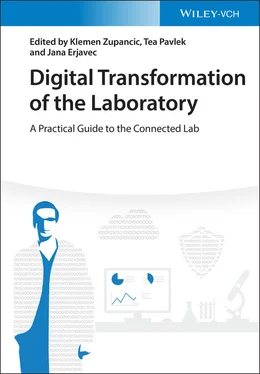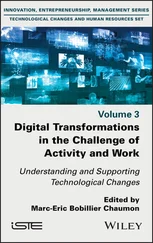The LotF and the people who work in it will undoubtedly be operating in an R&D world where there is an even greater emphasis on global working and cross‐organization collaboration. Modern science is also becoming more social [3], and the most productive and successful researchers will be familiar with the substance and the methods of each other's work so breaking down even more the barriers to collaboration. These collaborative approaches will foster and encourage individuals' capacity to adopt new research methods as they become available; we saw this with the fast uptake of clustered regularly interspaced short palindromic repeat (CRISPR) technology [4]. “Open science” [5] will grow evermore important to drive scientific discovery. This will be enabled through the increased use of new cryptographic Distributed Ledger Technology (DLT) [6], which will massively reduce the risk of IP being compromised [7]. The LotF will also enable more open, productive, collaborative working through vastly improved communication technology (5G moving to 6G) [8]. The people working in these labs will have a much more open attitude, culture, and mindset, given the influence of technology such as smartphones on their personal lives.
Robotics and automation will be ubiquitous, but with more automated assistance, the density of people in the lab will likely drop, allowing scientists to focus on key aspects and complex parts of the experiments. As a consequence, issues around safety and “lone working” will grow, and a focus on the interaction points which scientists have with automation will develop to ensure they are properly protected. For the few remaining lab technicians, not only will safe working become of increased importance, but the need for organizations to deliver a better “user experience” (UX) in their labs will become key to help them both attract the smaller numbers of more expert technicians and also retain them. The lab technician's UX will be massively boosted by many of the new technologies already starting to appear in the more future‐looking labs, e.g. voice recognition, augmented reality (AR), immersive lab experience, a more intelligent lab environment, and others (see later sections).
The lab processes, or “how” science gets done in the LotF, will be dominated by robotics and automation. But there will be another strong driver which will force lab processes and mindsets to be different in 5–10 years time: sustainability. Experiments will have to be designed to minimize the excessive use of “noxious” materials (e.g. chemical and biological) throughout the process and in the cleanup once the experiment is complete. Similarly, the use of “bad‐for‐the‐planet” plastics (e.g. 96/384/1536‐well plates) will diminish. New processes and techniques will have to be conceived to circumvent what are standard ways of working in the lab of 2020. In support of the sustainability driver, miniaturization of lab processes will grow hugely in importance, especially in research, diagnostic, and testing labs. The current so‐called lab on a chip movement has many examples of process miniaturization [9]. Laboratories and plants that are focused on manufacturing will continue to work at scale, but the ongoing search for more environmentally conscious methods will continue, including climate‐friendly solvents, reagents, and the use of catalysts will grow evermore important [10]. There will also be a greater focus on better plant design. For example, 3D printing [11] could allow for localization of manufacturing processes near to the point of usage.
In the previous paragraph, we refer to “research, diagnostic, and testing labs” and to manufacturing “plant.” We believe there is a fundamental difference between what we are calling hypothesis‐ and protocol‐driven labs, and this is an important consideration when thinking about the LotF. The former are seen in pure research/discovery and academia. The experiments being undertaken in these labs may be the first of their kind and will evolve as the hypothesis evolves. Such labs will embrace high throughput and miniaturization. Protocol‐driven labs, where pure research is not the main focus, include facilities such as manufacturing, diagnostic, analytical, or gene‐testing labs. These tend to have a lower throughput, though their levels of productivity are growing as automation and higher quality processes enable ever higher throughput. In these labs, reproducibility combined with robust reliability is key. Examples in this latter area include the genomic screening and testing labs [12, 13], which have been growing massively in the past few years. For these labs the already high levels of automation will continue to grow.

Figure 1.2 Virtual and real design‐make‐test‐analyze (DMTA) concept.
In the hypothesis‐driven lab [14] with the strong driver of sustainability combined with the growth of ever higher quality artificial intelligence (AI) and informatics algorithms, there will be more in silico, virtual “design‐make‐test‐analyze” (vDMTA) and less, tangible Make and Test (see Figure 1.2). Fewer “real” materials will actually be made and tested, and those that are will be produced on a much smaller scale.
Finally, as labs get more sophisticated – with their high levels of automation, robotics, miniaturization, and data production (but with fewer staff) – combined with the need for those facilities to be both safe and sustainable, the concept of “laboratory as a service” (LaaS) will grow [15]. The LotF will not be a static, self‐contained, and single scientific area facility. It will be a blank canvas, as it were, in a large warehouse‐like facility or cargo container [16] which can be loaded up on demand with the necessary equipment, automation, and robotics to do a contracted piece of lab work. That piece of work might be a chemical synthesis or a cell‐based pharmacological assay one day, and an ex vivo safety screen in the same area the next day. The key will be use of a modular design supported by fully connected devices.
1.2.3 Lab Environment and Design
The lab environment, its design, usability, and sustainability are mentioned previously in this section and elsewhere in the book, but it is fair to say that all labs will face the pressure [17, 18] to design sustainable spaces [19] that can keep up with all the emerging technical trends as well as the usability and design features needed to support a new generation of scientists. These drivers will combine to influence how the LotF evolves and experiments are performed. Research institutions are already creating more “open” labs areas to support interdisciplinary teamwork, collaborative working, and joint problem solving, rather than the previous “siloed” departmental culture. This will continue in the LotF. The growth of innovation clusters [20] and lab coworking spaces will require more consideration as to how shared automation and lab equipment can be effectively and securely used by groups, who may be working for different organizations and who will want to ensure their data and methods are stored and protected in the correct locations. Effective scheduling will be critical in the LotF to enable high productivity and to ensure that the high value of the automation assets is realized.
1.2.4 Data Management and the “Real Asset”
It is true of 2020, just as it was 50 years ago and will be in 50 years time, that the primary output of R&D, in whatever industry, is data. The only physical items of any value are perhaps some small amounts of a few samples (and sometimes not even that) plus, historically, a lot of paper! It is therefore not surprising that the meme “data is the new oil” [21] has come to such prominence in recent times. While it may be viewed by many as hackneyed, and by many more as fundamentally flawed [22], the idea carries a lot of credence as we move toward a more data‐driven global economy. One of the main flaws arising from the oil analogy is the lack of organizations being able to suitably refine data into the appropriate next piece of the value chain, compared to oil, which has a very clear refining process and value chain. Furthermore, the “Keep it in the Ground” [23, 24] sustainability momentum makes the data‐oil analogy perhaps even less useful. However, within the LotF, and in a more open, collaborative global R&D world, experimental data, both raw and refined, will grow in criticality. Without doubt, data will remain a primary asset arising from the LotF.
Читать дальше












